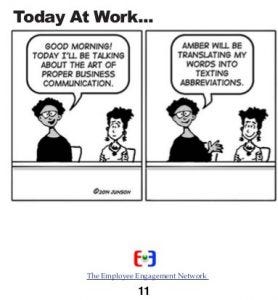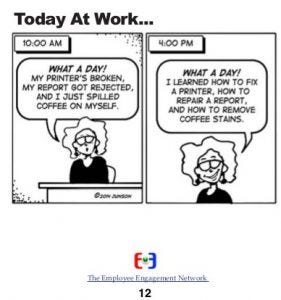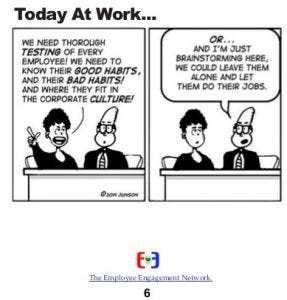Employee Engagement: How to Curate Safe Environments
This was originally posted on Medium
As an Appreciative Inquiry and positive psychology practitioner , Licensed Clinical Professional Counselor (LCPC), wife, and mother, I am interested in the intersection of home, school, work, and play. How aligned are we across these domains of life, and how does that impact our engagement in them?

I was driving home from dropping my children off at school when I heard a news report regarding employee engagement at work. It referenced a study conducted by Ultimate Software and The Center for Generational Kinetics. The study posited that employee emotional safety was a huge indicator for employee engagement. I was stirred by the discussion and decided to read the study for myself as well as dive further into the topic.
Gallup 2016 Research showed that only 13% of employees worldwide are engaged with 32% engagement in the United States. Engagement means being involved in, enthusiastic, and invested in the workplace. This has implications for the well-being of a global society.
The numbers haven’t changed much since Gallup first started tracking the data in 2000. Consider the toll this takes on families, marriages, parenting, and societal outcomes. What kind of people are we cultivating? We spend a large portion of our lives at work. Our level of happiness is contagious. How can we create positive contagion at work? How can we feel like what we do at work matters so that what we do at home does as well? I wonder what is the result of a global workforce that isn’t engaged in what they do at work.
Good News for Employers and Employees
A review of the literature identifies ways to curate an engaged workforce and also have a larger positive impact on the world. According to Ante Glavas, Associate Professor in the Kedge Business School, a combination of Perceived Organizational Support (POS) and Corporate Social Responsibility (CSR) are keys to cultivating employees and organizations that are positively aligned.

According to Robert Eisenberger and colleagues at the University of Houston, ways to cultivate perceived organizational support include helping employees feel heard, respected, and trusted with their time and that they have a say in the organization’s policies and procedures. Other indicators included fair compensation strategies and attainable reward compensation initiatives as well as reward systems for superior performing employees.
Employees who could trust their supervisors, and supervisors who could trust upper level management indicate higher scores in perceived organizational support, which is considered altruistic when it comes out of the organization itself, not as a result of a government policy mandate or because the organization accrues some advantage such as a tax credit. This is similar to intrinsic motivation in individuals.
Other suggestions included having policies that give managers discretion. This means that managers are not just doing what they’re required to do and being diplomatic about how management practices are enforced, but also being flexible to fit specific situations. For example, a manager with discretion can make allowances for difficult circumstances arising in an employee’s personal life without the employee being penalized for it.

For example, a male employee is equally engaged in raising his children and does not expect that his wife will always take off from work when the children are ill. His wife had taken two days off to be with their son running a high fever. She could not take more time off that week, so her husband had to use sick time to care for their son. His supervisors could work with him, allowing him to log in from home and work as much as he could, thus not requiring a full sick day. Supervisors that can use their best judgment to deal with specific situations are thus interpreting company policy to the benefit of everyone by allowing flexibility where needed.
Employees value being trusted with their time, supported when they need to address personal concerns, and knowing that their superiors trust them to be accountable for getting their work done. Many families are juggling full-time work with caring for children and perhaps aging parents. It is becoming more common for couples to share these responsibilities with their significant others.

Other actions suggested by the research include cultivating strong social networks at work and allowing for volunteer opportunities. It is better not to require participation in social occasions and volunteer opportunities because that would add additional pressure to employees. But when these activities are offered, they can build good will in the office and affirm corporate social responsibility by giving the company and employees chances to have an impact outside of work.
Attracting employees aligned with the organization and responding to them promptly throughout the interview and hiring process lead to potential employees feeling valued even before they start work at the organization. Ensuring a healthy, safe, harassment-free environment and providing employees with the proper tools and technology also support an engaged workforce. According to Glavas, employees thrive when they can bring their whole selves to work and their own skills and abilities are aligned with an organization’s mission. Employees tend to put their best selves forward when they see they have a greater impact either as a result of the organizational mission or through volunteer opportunities arranged through work.
What would the world, our families, relationships and life look like if we were all positively engaged employees? We don’t need to reinvent the wheel. We need to listen and respond so that we are all heard, supported, respected, and doing work we love. It’s then that employees will advance organizations and families and the good work can get done.
References
Dorsey, J. & Rogers, A. (2016). Uncovering the positive drivers of employee experience. White paper presented by Ultimate Software and The Center for Generational Kinetics.
Eisenberger, R., Malone, G. P. & Presson, W. D. (2016). Optimizing Perceived Organizational Support to Enhance Employee Engagement. Report issued by Society for Human Resource Management and Society for Industrial and Organizational Psychology.
Glavas, A. (2016). Corporate Social Responsibility and Employee Engagement: Enabling Employees to Employ More of Their Whole Selves at Work. Front. Psychol. 7:796. doi: 10.3389/fpsyg.2016.00796.
This is an open-access article distributed under the terms of the Creative Commons Attribution License (CC BY). The use, distribution or reproduction in other forums is permitted, provided the original author(s) or licensor are credited and that the original publication in this journal is cited, in accordance with accepted academic practice. No use, distribution or reproduction is permitted which does not comply with these terms.
Mann, A. & Harter, J. (2016, January 7). The Worldwide Employee Engagement Crisis. Gallup Business Journal.
Image Credits
These images come from David Zinger’s site. David is an employee engagement speaker. Here’s the statement on his site about the pictures:
My friend and resident Employee Engagement Network cartoonist, John Junson has created an e-book with 15 free cartoons that you can use for work. Pass it along to a colleague. Use it in a presentation. Pin one cartoon to your wall or cubicle. Choose one a month and put it in your newsletter. Stress is a staff infection and humour is contagious so use the humor here to fight stress at work.


